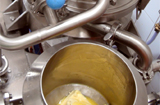Contaminating microorganisms lead to spoilage of fresh produce, sometimes even forming life-threatening toxins.
Food must therefore be sterilized as far as possible and filled or packaged under hygienic conditions. Traditional methods of preservation such as heat sterilization have the disadvantage that they destroy valuable heat-sensitive ingredients in the food, such as vitamins, and thus reduce the nutritional value. The addition of chemical preservatives can also have negative effects. Alternatives are therefore needed.
Physical processes for sterilization
The development of new processes for the hygienization or sterilization of biogenic products such as foodstuffs is the focus of the "Aseptic Systems" working group at Fraunhofer IGB. We are investigating various physical processes, such as microwaves or pressure swing technology, to determine their effect on inactivating microbial contamination. We also take into account the effects on ingredients.
One focus of our work is to understand the interaction of the various parameters in the system (temperature, pressure, particle size, viscosity, pH, etc.) in order to be able to optimize the processes technologically and implement them in a production plant. If we recognize process-technical or energetic advantages, we develop the processes further and optimize them for the respective application.
Integrated process approach
In order to be able to present real alternatives, the developed processes must be adapted in their conception to the requirements of a food production process. For this purpose, an overall analysis from product development, processing and stabilization to plant engineering and packaging must be carried out and validated. Concepts of hygienic design and CIP cleaning (cleaning in place) play a central role here. We also look at these systems in terms of their energy efficiency.
Example: Automated production of a choux pastry free of preservatives
Choux pastry or choux mass is used to bake pastries such as cream puffs, doughnuts, éclairs, profiteroles or apricot dumplings. Up to now, choux pastry has had to be produced in a time-consuming manual process. After production, it must be processed very quickly because its composition makes it unstable. Therefore, choux pastry is increasingly being replaced by ready-made baking mixes, which are mainly used by large bakeries producing for discounters. However, these contain chemical additives and no longer have the high-quality character of traditional choux pastry products.
In the EU-funded "ProEclair" project, Fraunhofer IGB and its project partners have developed an automated process for the production and packaging of traditional choux pastry under aseptic conditions. The system is particularly suitable for the centralized production and decentralized further processing of choux pastry in different branches, thus enabling smaller bakeries to produce high-quality pastries at competitive prices.
The choux paste is filled directly into sterile-sealed piping bags, so that the packaged choux paste can be kept ready for use for four weeks at a temperature of 4 °C. The choux paste can also be used for the production of other baked goods. The baking properties as well as the sensory characteristics of the developed choux paste correspond - even after a longer storage period - to those of traditional, freshly prepared choux paste. A first prototype of the production system was set up in a bakery. The system is also equipped with the possibility of in-situ cleaning (CIP).
Outlook
The development of processing methods that are gentle on the product and minimize the loss of valuable ingredients such as vitamins is increasingly in demand for food as well as cosmetics and pharmaceutical production. The further development and process optimization of alternative methods and their integration into the production process are carried out in accordance with current GMP standards (Good Manufacturing Practice) and risk analysis procedures such as HACCP (Hazard Analysis and Critical Control Points).
 Fraunhofer Agriculture and Food Industry Alliance
Fraunhofer Agriculture and Food Industry Alliance
